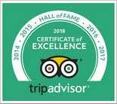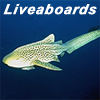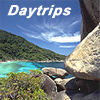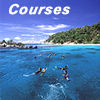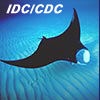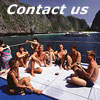Phuket Thailand travel guide - General information
Climate
Phuket has a moist, tropical climate, influenced chiefly by monsoon winds that vary in direction according to the season.
From March to September, as the sun's rays strike directly above the equator, the land mass of Asia is heated more than is the Indian Ocean. This draws moist hot air from the ocean over Phuket and southern Thailand, bringing the rains of the southwest monsoon. By mid-April the winds are mainly from the southwest and are heavy with moisture.

During the month of May, it will rain an average of 25 days making it one of the wettest months of the year. When the tilt of the earth brings the direct sun rays south of the equator, the heating of the Indian Ocean draws the cooler dry air of the northeast monsoon from the highlands of Asia across the countries of South and Southeast Asia.
By October the direction of the wind will have shifted to the northeast and Phuket will experience another intense but briefer wet period as the northeast monsoon sweeps down the east coast of Thailand and moves back into the Indian Ocean.
By mid November the weather on Phuket will be somewhat cooler and dryer, until March when the weather becomes perceptively warmer and more humid preceding the onset of the next monsoon.
Visiting Phuket during the monsoon season is not unpleasant because most days are rain-free except for showers in the afternoon. Phuket averages 2540 mm (or about 100 inches) of rain each year.
People
Phuket has a population of 200,000. The main centers of population are on opposite sides of the island. Phuket Town, with a population of about 63,000, is located on the east side and Patong Beach, whose population varies widely depending on the time of year, is located on the west side.
The residents are Thais who migrated from the mainland, Chinese who arrived to work the tin mines, Muslims of Malaysian extraction -- many of who come to work the rubber plantations -- and Chao Nam or sea gypsies -- who may have occupied the area for a millennium or more.
The Chinese now comprise 35 percent of the island’s population. They differ from those who settled in Bangkok and many other areas of Thailand in that they came from the Hokkien region of China, as did those who settled in Singapore and Malaysia. As elsewhere in Asia, many of the Chinese have made the transition from providing cheap labor to being merchants. The Chinese have inter-married with native Thais and have largely been assimilated into Thai culture. Today the descendants of the early Chinese settlers are responsible for much of the trade and commerce that take place on the island.
The influence of Indonesian-Malayan culture is still apparent today in the ethnic makeup, language, art, and religion of the southern Thais. About 35% of the Thais living on Phuket are Muslims. Concentrated mostly around Surin and a few other big villages, they work as rice and rubber farmers. In addition to Thai and Malay languages many also speak 'Yawi', an ancient dialect of the Malayan language.
One of the most interesting groups of people who have lived on Phuket are the (or Sea Gypsies), traditionally a nomadic peoples who traveled from cove to cove, staying until the fish and other resources were depleted. They then moved on, allowing the cove to re-establish its former ecological balance before returning to repeat the cycle. Their history and cultural lifestyles are hard to trace as they do not have a written language. Sea gypsies are said to have originated in the Andaman and Nicobar Islands between India and Burma. They are generally darker skinned and heavier with curly black hair. They speak their own language and follow their own animistic religion.
Sea Gypsies consist of three groups. The Mokens still prefer their ancestral sea nomad-style of living and are commonly found occupying the islands north of Phuket. The Orung Laut and the Moklens have settled on coastal areas. There are three Sea Gypsy villages in Phuket. The one located at Rawai is thought to be the oldest and is visited by busloads of tourists everyday. Another village is located 8km north of Phuket Town at Sapam Coast, and a third village is located on Siray Island which is accessible by bridge from Phuket Town.
The Monarchy
The King, Queen and the Royal Family are genuinely respected by the Thais. Most homes and businesses, have one or more photographs of the King or the royal family prominently displayed.
Showing any form of disrespect to the Royal Family will not be appreciated by the Thais and could cause you serious problems.
If you attend a cinema during your stay, when the portrait of the King is shown on the screen during the national anthem you are expected to rise and remain standing for the duration.
Social Customs
Thailand is known as the "Land of Smiles", and for its tolerance and hospitality. The simple rule is that if you smile people will like you. A smile is an easy way to say "thank you" and can also be used to 'excuse yourself' for small inconveniences. A smile is the proper response to acknowledge the wai or greetings of small children, and with hotel and restaurant staff.
Most of us were raised with the "Golden Rule" and that will work for you as well in Thailand as it does at home. Nevertheless, we will provide you with a short list of things that you should know to help you overcome any ‘culture shock’ you may encounter:
- If you are invited into a Thai home, you are expected to remove your footwear before entering the door
- It is considered disrespectful for anyone to put his feet on the table while sitting. When seated make sure your feet are not pointed at anyone as this is offensive to Thais
- Thais regard the head as the highest (purest) part of the body, so refrain from touching or patting the head in a friendly gesture because it is considered impolite
- It is not proper to lose one's temper or show exasperation during a misunderstanding. "Jai yen", or a "cool heart" the Thais believe will solve the problem
Visiting a temple
Is one of the more interesting cultural activities for visitors
during their stay in Thailand. Visitors are welcome and discreet
photographs may be taken. Shoes must be taken off before entering
a temple, wearing shorts or other revealing clothing is frowned
upon.
Monks are the most important people in Thai society and must be
treated with respect at all times. A monk's vow of chastity
prohibits him from touching or being touched by a woman. Women are
usually advised to smile and slightly bow when encountering a monk
and maintain enough distance to prevent any contact with the monk
or his robes.

If you get up early (sunrise) for a walk, you are likely to encounter monks making their rounds for offering of food. Monks carrying a bowl will be approached by Thais (usually women) who will offer food to the monks (merit making). Thailand is a Buddhist country and this ritual can be seen every day all over the country.
National Parks
The Khao Pra Thaeo National Park is Phuket's last natural reserve and a beautiful place where ferns and mosses grow on rocks and fallen trunks while handsome hardwood tress soar straight up into the sky. Palm trees and other jungle growth combine to give that majestic feel of a virgin triple canopy forest.
The park was declared a natural preserve in July 1980 and covers over 22 sq. kilometers of virgin rain forest. The park is known for its many species of trees especially palms, one of which the'White Backed Palm' grows nowhere else on earth.
Many kinds of wild animals can still be found in the park including langurs, monkeys, barking deer, wild boars, squirrels, and numerous species of birds and reptiles. The park is an important source of water for the island and streams in the park feed two waterfalls of interest.
Language
Even a modest attempt to speak Thai will earn you a happy smile and respect from many Thais. Thai is a tonal language and by slightly rising or lowering the tone will change the meaning of the word. The word "my" can have five different meanings all controlled by the tone in which it is pronounced.
Thai also uses a slightly different vocabulary for men and women. The masculine Thai word for "me" or "I" is pom , the feminine equivalent is dichan. Thais always include a polite closing word to a statement, men finish a sentence with the Thai word Krup and women close with Ka. The words have little if any direct translation but a Thai will think very highly of you if you use it.
Farang may be the first Thai word that you encounter during your stay in Thailand. Thais use the word "farang" to refer to Caucasian people, or things associated with them (such as western food ahan farang). The word is commonly believed to be derived from the Thai pronunciation of the name of a early visitor from Greece, Constantine Phaulkon who figures prominently in Thai history.
Phuket Town
Founded a little over a century ago by Chinese and Malaysian merchants to service the nearby tin mines, and the harbor near Phuket was better suited to handle larger ships than the traditional capital city of Thalang. It spite of growing pains that come with being a boom town and a major fire that destroyed much of the city Phuket town grew and prospered to become the commercial, social, and political center of the island.
The beginning of the 20th century was a period of positive growth for Phuket. Tin mining boomed, and the very capable and benevolent governor Rasada Korsimbi helped diversify the island’s economy and the capital city of Phuket began its modern expansion. The town of Phuket grew rapidly, its streets lined with handsome buildings, and ships from all over the world called at its bustling port.
Today the main attractions in Phuket Town are the old Sino-Portuguese buildings, the elaborate Chinese and Thai temples, and the public markets. Most of the buildings in Phuket’s city center were constructed nearly a hundred years ago, during the period of the first great tin boom. These building show mixed Chinese and western influences in their architecture called Sino-Portuguese.
It is a style common to all coastal tin-mining settlements on the Malay Peninsula. The buildings are characteristically much longer than they are wide, and the entry ways have fancy latticework. Many lovely examples can be found on Dibuk Road, if you take the town walk-a-about you will pass many of the more important of these buildings. Phuket’s Town Hall, Provincial Court, and Nakorn Luang Bank are also good examples of this style of architecture. Phuket’s Town’s oldest public structure, Government House, is a wonderful example of architecture from earlier this century. Moviegoers may recognize it as the ‘American Embassy’ in Phnom Phen in The Killing Fields.
The last few years Phuket has experienced a significant growth but has managed to retain a lot of its original flavor derived from its multicultural roots. The best way to appreciate the full layout of Phuket is to hike up Rang Hill, just to the town’s north.
Money
Thailand's Currency is the Thai Baht, and the exchange rate towards the US$ is around 30 Baht for 1 US$. Commercial banks, currency exchanges, ATM Machines and major hotels provide currency exchange services at Phuket's major beach centers. Credit cards are widely accepted.
Accommodation
Phuket has many different types of accommodation to choose from. These range from basic bungalows/guesthouses with fan and approx 5 minutes walk to the beach for $10-15 USD; air-con guesthouses/hotels for $20-40 USD; and luxury resort hotels from $50 USD and upwards. Accommodation can be found in all major centers, either with plenty of night-life or in quiet, secluded bays around the island.
Water
Tap water is not safe for drinking. Drink only bottled water or from a flask supplied by the hotel. Water provided in restaurants is safe for drinking, but avoid all shaved or crushed ice particularly from roadside fruit venders.
Food
Few places in the world can provide the quality and variety of food available here in Phuket. You can choose between local Thai restaurants and every kind of Western/European cuisine. Thai food in Phuket, and throughout southern Thailand, is heavily influenced by the bountiful harvest of fresh seafood from the Andaman Sea. Seafood served southern style is unique, likely to be barbecued, and employs numerous herbs and spices, garlic, lemon grass, chilies, mint, cumin, basil, coriander, and shrimp paste.
Thais love to eat, and you will rarely be more than five minutes from a place serving food. The most common Thai eating place is a roadside hawker food stall. A local Thai will have a favorite hawker food stall for just about every different type of Thai food. Some may look a little shabby by western standards, but a visitor with a little sense of adventure will discover some of the tastiest and most inexpensive food ever eaten. To locate a good hawker stall watch where the Thais eat and join them.
During your stay in Thailand it is recommended that you eat Thai food as often as possible. Thais are justifiably proud of their food. It is always made from fresh ingredients, usually purchased from the market that day and is sure be well prepared.
Most Thai food is not spicy or hot. The condiments and sauces served with your meal (mostly for dipping food into) can be very hot and spicy. Simply control the use of these and you will generally be able to enjoy a wide array of Thai food and not have an unpleasant experience.
Fruit
Phuket Island is a tropical fruit version of heaven. Every day
all year long a variety of sweet succulent delicious fruits are
in season and ready for you to enjoy. Thais traditionally finish
a meal with a serving of fruit and save the sweeter Thai desserts
for snacking between meals. Many tropical fruits are grown right
here on Phuket Island.
- Pineapple - Pineapple grown here is famous throughout Thailand for being particularly sweet and crunchy and is a major export product.
- Rambutan - a cute, small red oval fruit with hair. On your first encounter you may not know if you should eat it or pet it; but inside is a sweet taste treat that is unfortunately too fragile for export.

- Bananas - small and sweet. Available all year.
- Papaya - has a sweet orange flesh and is a favorite dessert. Like many tropical fruits, it is also eaten green, served in the famous Som Tam (papaya salad).
- Durian – perhaps the king of tropical fruits. It has a bit of an odor problem, but definitely is a taste treat you don’t want to miss. Available in the spring months only.
- Rose Apples – a bell-shaped, green, waxy-looking fruit available most of the year, the flesh is sweet and crunchy - a favorite with children.
- Mango – the national fruit is delicious, sweet and juicy when ripe, but can also eaten green - dipped into a blend of sugar, salt and chili.
Postal and Overseas Telephone Services
The Post Office in Patong is on the Beach Road. Upstairs is a overseas telephone service that is much cheaper than that offered by hotels and guest houses. The hours are 8 am to 11 pm daily.
There are two post offices in Phuket Town. The largest is located on Montri Road and the branch is on Yaowarat Road behind the market square. There is also a smaller post office on Kata Beach and Chalong.
Medical Facilities
Phuket Town has three modern hospitals that offer 24-hour emergency medical services with patient transfer services to larger hospitals located in Bangkok and Hat Yai.
In addition, Phuket hospitals are linked to the SOS International for medical assisted homeward flights. Most hotels and guest houses are linked with a 24-hour medical service.
Ambulance services are available if needed. In Patong the Kathu Hospital has nurses available to treat minor medical ailments and a ambulance service for more serious medical conditions.
Tourist Police
Are there to assure your visit is as safe and pleasant as possible. Tourist Police stations are located in the major tourist areas of the island, in Patong the police office is located in the middle of the beach at the intersection of the Beach Road and Soi Bangla.
Most tourist police speak English and a few will speak Japanese
other European languages. If you become involved in a dispute during
your stay and do not feel you are being treated fairly, hold your
ground and call for the Tourist Police. That, in many cases, will
be enough to resolve the issue. The tourist police are very familiar
with all the local scams, and the operators who run them.
Dive Asia - Phuket Thailand
Office Address: 8/30 Soi Yodsanee, Chalong, Phuket 83150, Thailand
Phone: +66 (0) 818948588 or 0899736005
Visit us at one of our Offices: (Google Map)
Email:
Website: www.diveasia.com
24 Hour Hotline: +66 (0) 818948588



